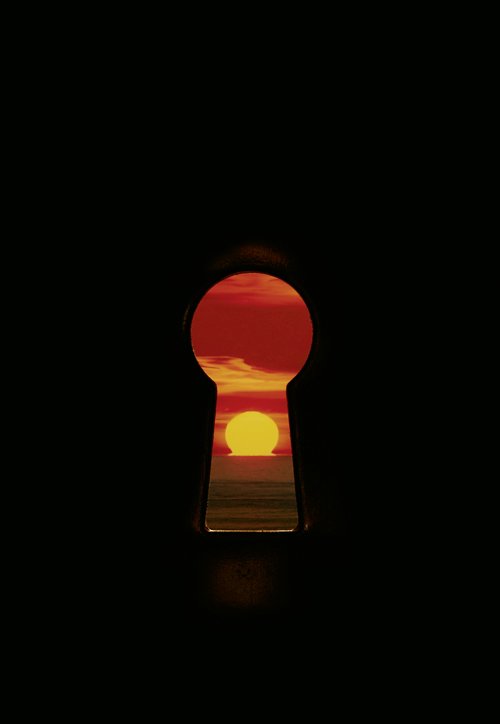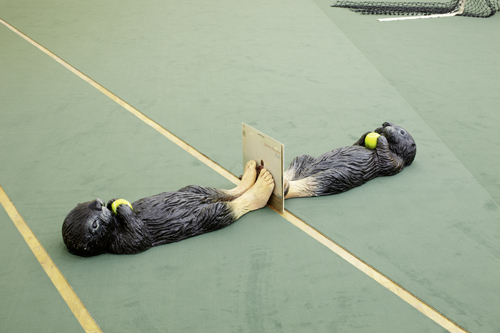Here Comes the Sun
From Californian glamour and Hollywood dreams to loss, loneliness and despair: comedy and melancholy in the work of Friedrich Kunath
From Californian glamour and Hollywood dreams to loss, loneliness and despair: comedy and melancholy in the work of Friedrich Kunath

Standing with his back to the viewer, the golden-haired man is wearing an elegant pale-grey suit. In his hands, clasped behind his back, he holds an equally smart homburg hat and a neatly rolled cane-handled umbrella. Perhaps just approaching middle age, his stance is assured and alert; his sartorial style appears mid-20th century, originating perhaps in Munich or New York or any other sophisticated metropolis. This patrician-looking gentleman seems somehow timeless and stateless – the art lover as time traveller, the aesthete as archetype.
He appears absorbed in the contemplation of a relaxed group of four cartoonish card players, seated on a raft made of six hefty and uneven planks. Blasé, interested only in their game, this quartet might be hobos or shipwrecked sailors. But their wooden raft seems to float like a magic carpet across a varicoloured vista of sunset tangerine, dusky lilac and rich egg-yolk yellow. Upon this – repeated over and over, like a faintly disquieting wallpaper pattern – are grotesquely caricatured line drawings of what look like late 1960s to mid ’70s office workers, who have decided to let loose in an orgiastic swingers’ party. Another layer appears above their heads: seated or standing in ones and twos, barely dressed in rags, are occurrences of tiny, ruddy-faced figures. Oblivious to the happiness explosion going off all around them – they look like they might have drifted in from early 19th-century France.

This scene, depicted on a large, landscape-format painting, is wistfully titled God Knows, I Had Plans (2013) by the Los Angeles-based German artist Friedrich Kunath. Made in oils, acrylic, watercolour and silkscreen print on canvas, the painting’s pictorial style conflates tie-dye abstraction with near photo-realistic figuration, commercial cartooning with Tom Wolfe-style caricature and children’s illustrations dating from the past century.
Yet for all of this apparent merging of styles, which might re-route the temper to a form of Pop-savvy late modernism, Kunath is an artist who seems to have more in common with, say, Rodney Graham, in terms of what seems to be a career-long fascination with characters, narratives, scenes and habitations. Kunath, in one sense, appears to be creating a brightly coloured but moody fictional meta-reality within which he explores a fundamental sense of isolation. His work might remind the viewer of that remark by P. G. Wodehouse, defining two approaches to creativity: ‘[…] one is like mine, to treat life as a kind of musical comedy; the other is to go down deep, and not give a damn.’ Kunath, it seems, does both simultaneously.
To look at a painting depicting a person in the process of looking is an arresting experience. A fact not lost on the popular American artist Norman Rockwell (1894–1978) upon whose painting The Connoisseur (1962) Kunath’s God Knows, I Had Plans appears, in part, to be based. Kunath’s appropriation of Rockwell’s faintly dandified figure of the connoisseur, absorbed in contemplation, might seem to offer some summary of his own interests. As an artist who works across a vast range of media – from painting to film to sculpture to large-scale installation (the subjects and figures in which are often densely interconnected) – Kunath might seem to realize his particular vision from a rich connoisseurship of primarily, but not entirely comic, pop-cultural and mass media imagery.
In this sense, the golden-haired connoisseur of God Knows, I Had Plans is of course Kunath himself: a time-travelling anthropologist of the gently humorous and the anonymously poetic; as sleepless as any ghost, turning over in his mind a relay of banal yet engrossing commercial imagery, yet always against the long, low, minor chord of an eternal Californian sunset. Kitsch figurines, middle of the road (MOR) album sleeves, cartoons from decades-old magazines, funny signage, cheap and ill-fitting fancy dress costumes, slapstick visual puns, mawkish advertisements for long-forgotten perfumes and aftershaves, Scooby-Doo-era American Gothic, nursery rhyme and folk tale illustrations of an Old European persuasion and the profound melancholy of discarded personal effects. Such are the found materials from which Kunath appears to draw his inspiration and, more importantly, audition and recruit what might be called the dramatis personae of his art.

A multitude of largely friendly but anonymous presences, therefore, appear to inhabit the ‘world’ of Kunath’s art: from a cartoon orgy of lanky naked teenagers to a man in a ghost costume sitting on a rock; from a flotilla of primary coloured seals to a community of old suitcases – which may, or may not, contain yet further members of the artist’s anarchic, cheerful, lost, doomed and contented crew of familiars. They are all members of a vast army of workaday commercial imagery yet each with some pictorial tic or quirk that seems to make their presence linger.
With Kunath’s relation to these images in mind, we might remember J. R. Brown’s much admired pen and pencil drawing Dickens Surrounded by His Characters (1889–90) depicting the great Victorian writer seated at his desk while the cast of his novels take their place around him: emerging from drawers or arriving in happy squads from the distant prospect of the city of London. In the case of Kunath, however, the English literary gentility of such a fantasy would be vividly colourized and accelerated into cartoon chaos – bringing to mind more those collisions between a long-suffering human world and the slapstick mayhem of classic Hollywood animation – described for example by the Warner Bros. TV series Animaniacs (1993–98) or Robert Zemeckis’s 1988 film Who Framed Roger Rabbit. When Kunath opens his studio in Los Angeles every morning one might expect to hear the furtive scuttling of a choir of singing bananas or a cartoon drunk as they scurry away from daylight and direct confrontation with their human host.
But this connoisseurship of the ‘low’, unheeded and discarded forms of mass culture comprises only one half of Kunath’s vision and art-making process. For all its wit and vivacity, Californian glamour, pop cultural signage and Hollywood dream manufacture, his art seems as connected to loss, loneliness, despair and departure – to the twilit edges of the Jungian shadow of Los Angeles – as it is to the fragile and nervous promise of an endless summer: to the sun-baked depths of a Pleasant Valley Sunday in which intimations of mortality can be just as vivid as those in any fog-shrouded European cemetery.

Such existential melancholy is evinced by the titles alone of recent exhibitions of Kunath’s work: I’m Running Out of World (White Cube, London, 2013–14), A Plan To Follow Summer Around The World (Le Crédac, Ivry-sur-Seine, 2014) and Raymond Moody’s Blues (Museum of Modern Art, Oxford, 2013). Each seems to fixate on some manner of valedictory epiphany, in which the experience of being alive in a present reality (the ‘be here now’ of enlightened consciousness) is exchanged for a sense of having either fallen through the surface of life or pushed through some cosmic membrane which separates two distinct phases and experiences of existence. Raymond Moody’s best-selling book Life After Life (1975) is concerned with near-death and life-after-death experiences, while both I’m Running Out of World and A Plan To Follow Summer Around The World, as phrases, seem to merge a plea of resignation with a longing for disappearance.
It is this point of departure – the moment of farewell and the process of leaving – with which Kunath seems most concerned. The ‘journeying’ which features so frequently within his work seems more related to destiny or self-discovery than to actual travel. It is the shot at happiness, long fallen wide; in all of this we might discern the melancholy of German Romanticism transplanted to the sun-baked landscape of California.
Such a notion is typified by Kunath’s film Untitled (2009) in which a snowman (or a person wearing a snowman costume) bearing a suitcase is seen struggling laboriously across the desert, hopelessly disoriented. His plight is heartfelt – what worse situation might a snowman find himself in, beneath the blazing sun? It is as though the figure is doomed to forever hope to catch a flight out of the scorched and barren wilderness he wanders further and further into. The comedy and tragedy of his situation become one and the same: a symmetry that seems to render this unfortunate figure of winter nothing more than the stooge of cruel fate, floored by a rabbit punch of pure irony.

Kunath works across a variety of media, ceaselessly interrelating the themes and moods of his work and thus appears to imply the realization of a meta-world which lies beyond the inevitable failure of romanticism. In this, the various depictions of sunset, which featured in Kunath’s exhibition I’m Running Out of World (all titled The Real Realities (all 2013)), seemed to invoke the sense of an ending as an archetypical state, beyond which might be an exuberant after-life, at once absurdist, poetic and strange. Romantic failure, nostalgia, regret and loss become a form of heroic epiphany – their psychodynamics acted out by a cast of extras recruited from a virtually infinite directory of second-hand imagery.
Repeatedly, Kunath’s titles reinforce a notion of ending as a form of transcendence – finitude as portal, and failure as confirmation of a life that lets you down – the classic Romantic position from John Keats to Morrissey: The Closest We Will Ever Be (2009), Never Again, Again (2010), It’s Over, It’s Ended, It’s Finished, It’s Done (2010), What A Difference It Makes When It Doesn’t Make Any Difference Anymore (2013) or Death, Love, Depression, Love, Death (2013). In the last of these works a faceless, grey fedora wearing, pink tuxedo sporting, silvermoustachioed playboy is standing in somewhat ceremonious repose – cigarette held at waist height he weeps a vertical line of tears onto his shiny black left shoe. He seems to be in a moonlit glade, two tall white trees in the background, their tendril-like branches entwined as though lovers holding hands. A jumbled mass of ‘Psycho’ Gothic architecture rises up against the inky-violet night sky.
Death, Love, Depression, Love, Death might be seen as a further depiction of the archetypical dandy – the ageing playboy aesthete who weeps either because life will never seem so poignant or beautiful again, or because life’s poignancy and beauty are so fleeting. His position as a devotee of the romantic life is described in the writings of Søren Kierkegaard as one doomed to endless repetition, unable to transcend the despair of the aesthetic – a fate described, whether consciously or not, by the repetitions within the painting’s title.

It is little wonder therefore that Kunath seems so concerned with the imagery of sunset. His art seems suffused with the presence or diminishment of sunlight as a mood or metaphor in the same manner that it seems to chime, pitch perfect, with the luxuriant melancholy of Californian folk rock and MOR singer-songwriting of the mid 1970s. The Real Realities consolidates this motif, depicting a variety of rich-red sunsets, some with silhouettes of palm trees, on feint ruled notepaper.
Collectively, the impact of these sun-sets becomes chapel-like, appearing to comprise both a metaphor for departure and the preface to an afterlife. It is as though the symphonic manner in which the sinking sun underlighting the sky with deepening shades of red is a cumulative, slow building crescendo of valediction and farewell – from Francis Ford Coppola’s bravura use of The End (1967) by The Doors in Apocalypse Now (1979), to Joni Mitchell’s The Hissing of Summer Lawns (1975): the blue pools in the squinting sun, the imperious and eternal symbol and reality of the sun as life force, for Kunath, forever setting.
















